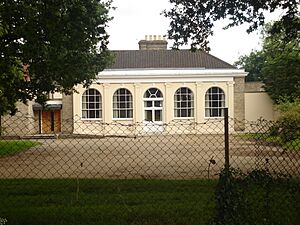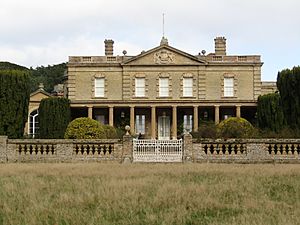Sir Standish Hartstonge, 1st Baronet facts for kids
Sir Standish Hartstonge, 1st Baronet (1627–1701) was an important lawyer from England who became a judge in Ireland. He had a very successful career but was removed from his job twice! He also owned a lot of land in both Ireland and England. Towards the end of his life, he had a big disagreement with his oldest grandson.
Early Life and Starting His Career
Standish Hartstonge was born in Norfolk, England, in 1627. He was the oldest son of Francis Hartstonge. His mother, Elizabeth Standish, came from a wealthy family. Because of his mother's family, Standish inherited a lot of money and land, including property in County Clare, Ireland.
Later in his life, he put up a special memorial at a church in Bruff, Ireland. This was to honor his grandfather, Sir Thomas Standish. The memorial shared interesting details about his family's history.
Standish started studying law in 1657 at a place called Middle Temple in London. He then moved to Ireland to continue his law career. In 1659, he joined the King's Inn in Dublin, which is another famous law school. He quickly became a very busy and successful lawyer.
He became the Recorder of Limerick, which was a top legal job in the city. In 1666, he became the second judge of the court in Munster, a region in Ireland. He was the last person to hold this job, as the court was closed in 1672.
His Career as a Judge
In 1680, Sir Standish was made a high-ranking judge called the Third Baron of the Court of Exchequer (Ireland). This court dealt with money matters for the government. The next year, he received a special honor from the King: he was made a baronet. This was a rare title for an Irish judge at that time. People said he got this title because he was so rich! Besides his lands in Ireland, he also owned property in Hereford, England, and a house near Dublin.
Sir Standish was known for being fair to Roman Catholics, even though many people at the time were not. This belief sometimes made others suspicious of him. In 1686, King James II, who was Catholic, suddenly removed him from his judge position. This probably happened because the new leader in Ireland, Richard Talbot, 1st Earl of Tyrconnell, was jealous of Sir Standish's wealth and high standing. After this, Sir Standish moved to Hereford, England.
After a big change in power in England called the Glorious Revolution in 1688, Sir Standish wanted to be a judge again. He returned to Ireland and got his old job back in 1691. However, the old rumors about him being too tolerant of Catholics came up again. Because of this, he was removed from his job for a second time in 1695. He went back to Hereford.
His last years were difficult. He had arguments with his oldest grandson, who upset him by marrying someone he didn't approve of. Sir Standish died in 1701.
His Family Life
Sir Standish Hartstonge was married three times. His first wife was Elizabeth Jermyn. They married around 1650 and had 11 children together. Seven of their children were still alive in 1676. Elizabeth passed away in 1663.
His second wife was Anne Bramhall, who was the daughter of the Archbishop of Armagh. They did not have any children. Anne died in 1682.
His third wife was Joanna Gwynne Price. She was a widow and had one son with Sir Standish, named Gwynne, who was born in 1685.
Sir Standish's oldest son, Francis, died in 1688. This meant that the baronet title passed to Francis's son, who also became Sir Standish Hartstonge, 2nd Baronet.
Many of Sir Standish's children and grandchildren became important people:
- His son, Standish, became a lawyer like his father and was a Member of Parliament (MP) for Kilkenny City.
- Another son, John, became a Bishop, first in Ossory and then in Derry.
- His daughter Alice married Anthony Maude, who was also an MP. Their children included Sir Robert Maude, 1st Baronet.
- His daughter Jane married Arthur Chamberlain Brownlow, an MP for County Armagh. Their son, William Brownlow, also became an MP.
Sir Standish decided to leave most of his land and money to his youngest son, Gwynne. This decision led to a long legal fight between Gwynne and the younger Sir Standish (his grandson). In the end, the court decided in favor of Gwynne.



